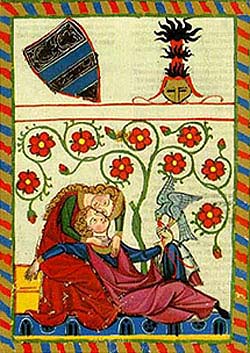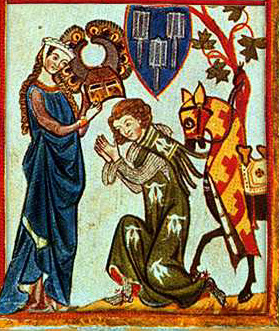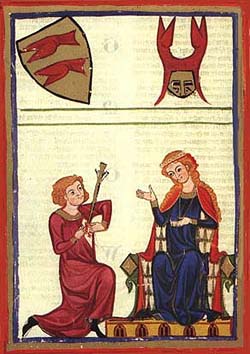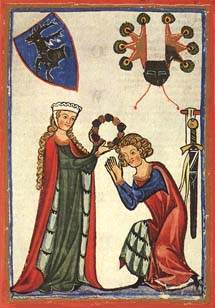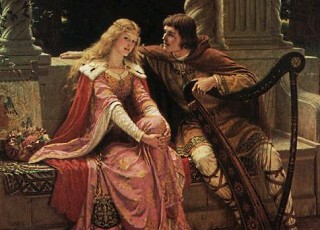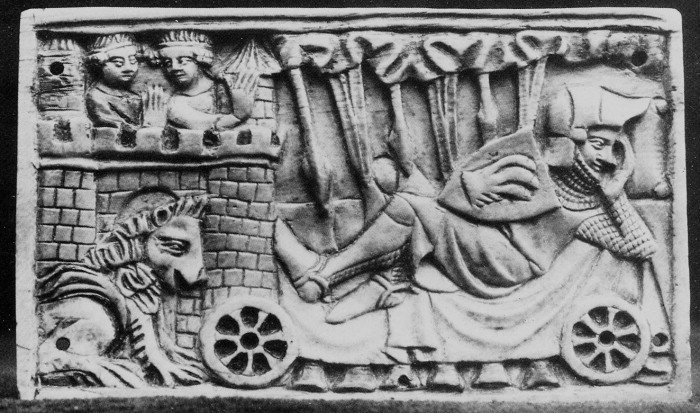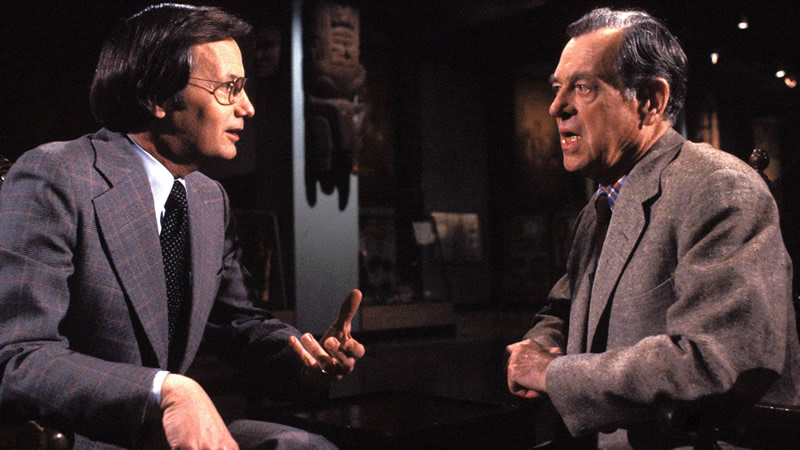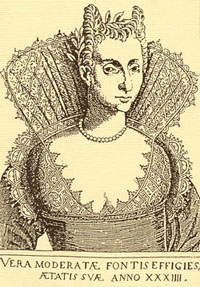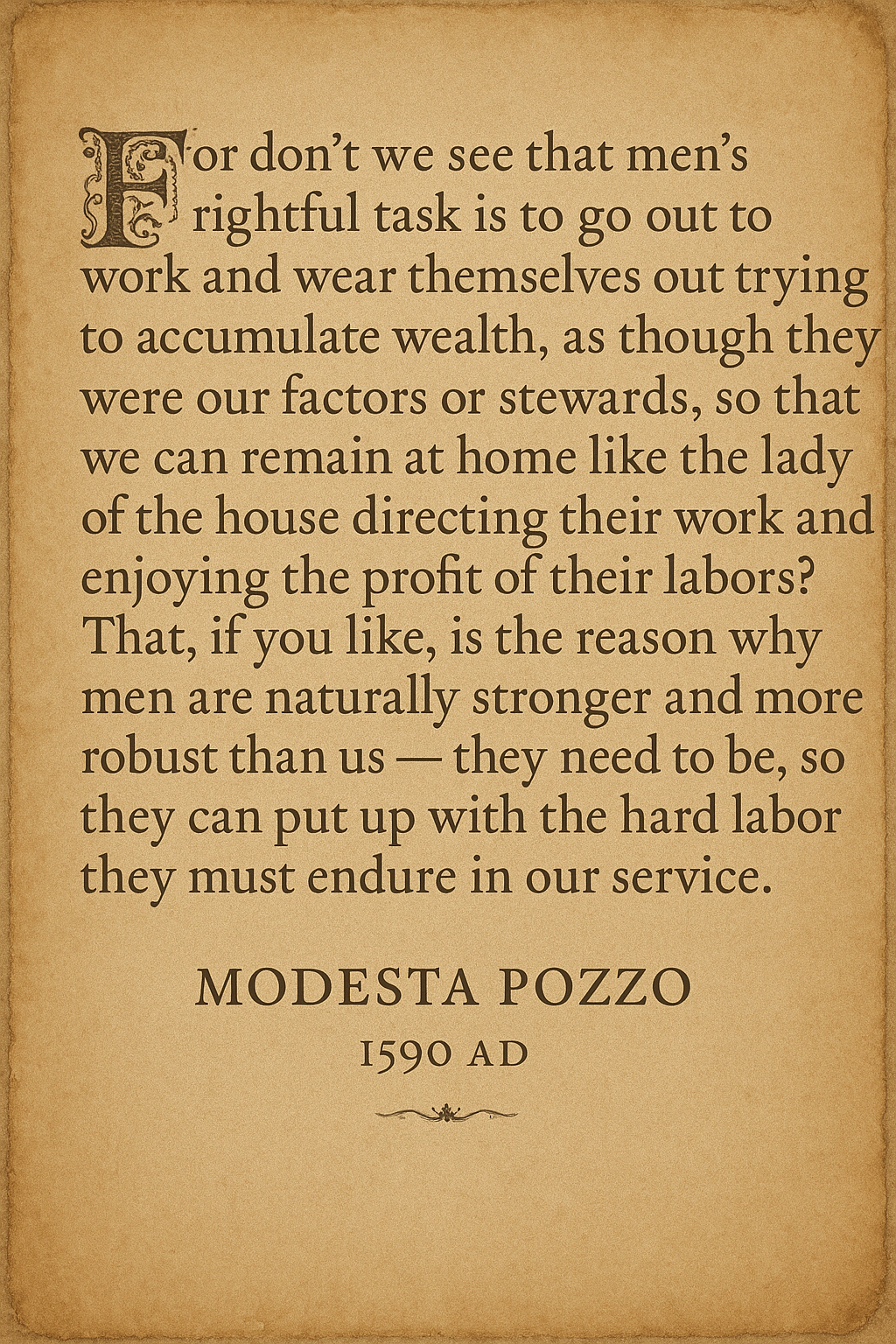The Rise of Courtly Love: Courtly Love and Cultural Influence
By Brandy Stark
History and origin:
The term amour courtois (courtly love) was given its original definition by Gaston Paris in 1883. In an article on Medieval behaviors, he proposed that the “lover” accepts the independence of his mistress and tries to make himself worthy of her by acting bravely and honorably and by doing whatever deeds she might desire. Sexual satisfaction was not necessarily the goal or even end result, though sexual attraction could be a part of courtly love.
- Though not directly addressed in Medieval writing, other terms, such as fin’amor (fine love) and other terms and phrases associated with “courtliness” and “love” are common throughout the Middle Ages.
- Given that practices similar to courtly love were already prevalent in the Islamicate world, it is very likely that Islamicate practices influenced the Christian Europeans.
- In 11th-century Spain, a group of wandering poets appeared who would go from court to court, and sometimes travel to Christian courts in southern France.
Definition:
Courtly love was the study of the bonds of humankind. It brought the elements of theological study into the secular mindset as the emotion of love combined with rational, critical thought. The eleventh century foundations of courtly love were, at first, a conception of love that defined friendship; love was seen as recognizing the virtue in another human being. It was also an ethical behavior, grace, and thought which aimed at the cultivation of virtue in the whole of mankind (Jaeger, 1994).
It found expression through the troubadours such as William IX, Duke of Aquitaine, in the 11th century. Sample of his writing:
I have given up all I loved so much:
chivalry and pride;
and since it pleases God, I accept it all,
that He may keep me by Him.
I enjoin my friends, upon my death,
all to come and do me great honour,
since I have held joy and delight
far and near, and in my abode.
Thus I give up joy and delight,
and squirrel and grey and sable furs.
Similar to a cult of friendship, writings document concern for the wellness of the reputation and standing among women. They also encourage men to forgo arrogance and to continue the study of how to win virtue.
One of its most important contributions was the elevation of the status of women. Eventually, courtly love evolved to the literature of leisure, directed to a largely female audience for the first time in European history.
How it worked: Poets declared themselves the servant/vassal of the lady and addressing her as midons (my lord), thus not revealing her name, and flattering her at the same time. The troubadour’s model of the ideal lady was the wife of his employer or lord, a lady of higher status, usually the rich and powerful female head of the castle. The poet gave voice to the aspirations of the courtier class, for only those who were noble could engage in courtly love (or could be engaged with higher education).
Other behaviors included:
- Announcing his attraction to the lady, usually via eyes/glance
- Worship of the lady from afar
- Declaration of passionate devotion
- Virtuous rejection by the lady
- Renewed wooing with oaths of virtue and eternal fealty
- Moans of approaching death from unsatisfied desire (and other physical manifestations of lovesickness)
- Heroic deeds of valor which win the lady’s heart
- (Literarily speaking): Consummation of the secret love
- (Literarily speaking): Endless adventures and subterfuges avoiding detection
.Courtly love saw a woman as an ennobling spiritual and moral force, a view that was in opposition to ecclesiastical sexual attitudes. Rather than being critical of romantic and sexual love as sinful, the poets praised it as the highest good. Marriage had been declared a sacrament of the Church at the Fourth Lateran Council (1215). Within Christian marriage the only purpose of sex was for procreation; the ideal state was celibacy, even in marriage. This may not have been hard to maintain as most marriages were arranged as part of the business/guild/and feudal system. This, then, allowed a man who was interested in a woman to aspire for her under chaste circumstances, seeking her first for her virtue. She was the unattainable ideal (a role that we also see with the Virgin Mary, who was also heavily promoted at this time).
Some of the finest writing can be found in the old French love lyrics from the early twelfth century. Women were portrayed as teachers of love offering instruction in virtue, and men were their students. The women of these poems taught that a lover must show generosity through acts of charity, particularly to impoverished nobles. He must be humble to all and ready to serve all. He must never speak ill of anyone, but where he sees evil men, he should discreetly reprove their bad behavior. He should never mock someone in distress. He should not be prone to quarrels and arguments, but rather should strive to reconcile disputes and arguments. Lastly, showing the depth of his cultivation, he should moderate his laughter, especially in the presence of women. These poems show the core of courtly learning: humility, generosity, gentleness, deference, and kindness. Virtually none of the lessons would have been out of place n the moral discipline of the schools, as passed from school master to student. The emphasis in these writings remains the aspect of manifesting virtue through behavior in order to make it visible (Jaeger, 1994).
As an example, read: DE ARTE HONESTE AMANDI [The Art of Courtly Love], Book Two: On the Rules of Love By: Andreas Capellanus: The Art of Courtly Love, (btw. 1174-1186) (exerted through the Medieval Sourcebook, url below):
1. Marriage is no real excuse for not loving.
2. He who is not jealous cannot love.
3. No one can be bound by a double love.
4. It is well known that love is always increasing or decreasing.
5. That which a lover takes against his will of his beloved has no relish.
6. Boys do not love until they arrive at the age of maturity.
7. When one lover dies, a widowhood of two years is required of the survivor.
8. No one should be deprived of love without the very best of reasons.
9. No one can love unless he is impelled by the persuasion of love.
10. Love is always a stranger in the home of avarice.
11. It is not proper to love any woman whom one should be ashamed to seek to marry.
12. A true lover does not desire to embrace in love anyone except his beloved.
13. When made public love rarely endures.
14. The easy attainment of love makes it of little value; difficulty of attainment makes it prized.
15. Every lover regularly turns pale in the presence of his beloved.
16. When a lover suddenly catches sight of his beloved his heart palpitates.
17. A new love puts to flight an old one.
18. Good character alone makes any man worthy of love.
19. If love diminishes, it quickly fails and rarely revives.
20. A man in love is always apprehensive.
21. Real jealousy always increases the feeling of love.
22. Jealousy, and therefore love, are increased when one suspects his beloved.
23. He whom the thought of love vexes, eats and sleeps very little.
24. Every act of a lover ends with in the thought of his beloved.
25. A true lover considers nothing good except what he thinks will please his beloved.
26. Love can deny nothing to love.
27. A lover can never have enough of the solaces of his beloved.
28. A slight presumption causes a lover to suspect his beloved.
29. A man who is vexed by too much passion usually does not love.
30. A true lover is constantly and without intermission possessed by the thought of his beloved.
31. Nothing forbids one woman being loved by two men or one man by two women.
Sources:
-Delahoyde, M. “Courtly Love” http://www.wsu.edu/~delahoyd/medieval/love.html, as retrieved July 7, 2007.
-Halsall, P. (1997) “Medieval Sourcebook: Andreas Capellanus: The Art of Courtly Love, (btw. 1174 –1186)” http://www.fordham.edu/halsall/source/capellanus.html, as retrieved July 7, 2007.
-Jaeger, S. (1994). The Envy of angels: Cathedral schools and social ideals in Medieval Europe, 950 – 1200. Philadelphia, PA: University of Pennsylvania Press.
-Schwartz, D. (2002) “Medieval Literature,” http://cla.calpoly.edu/~dschwart/engl203/margery203.htmlas retrieved July 7, 2007.
Editor’s note: Author email for article above could not be located. If the author has any concerns about this reprint please feel free to contact me.
